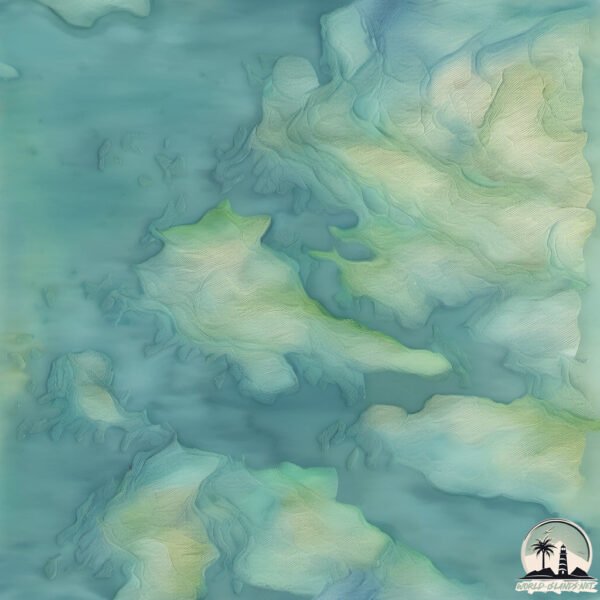Welcome to Aguirre , a Polar island in the South Pacific Ocean, part of the majestic Pacific Ocean. This guide offers a comprehensive overview of what makes Aguirre unique – from its geography and climate to its population, infrastructure, and beyond. Dive into the details:
Geography and size of Aguirre
Size: 21.8 km²Coastline: 56.7 kmOcean: Pacific OceanSea: South Pacific OceanContinent: South America
Aguirre is a Medium Island spanning 22 km² with a coastline of 57 km.
Archipel: Andes fueguinos – A subregion of Tierra del Fuego in the southernmost tip of South America, known for its rugged mountain landscapes and remote beauty.
Tectonic Plate: Scotia – Situated in the Southern Ocean, surrounding the Scotia Sea, between South America and Antarctica, known for the Scotia Arc and active seismicity.
The geographic heart of the island is pinpointed at these coordinates:
Climate and weather of Aguirre
Climate Zone: PolarClimate Details: TundraTemperature: Cold
Climate Characteristics: The tundra climate features long, extremely cold winters and short, cool summers. Vegetation is limited to mosses, lichens, and small shrubs due to the low temperatures and short growing seasons. Biodiversity is low, but some specialized species thrive.
Topography and nature of Aguirre
Timezone: UTC-04:00Timezone places: America/La_PazMax. Elevation: 434 m Mean Elevation: 169 mVegetation: Herbaceous CoverTree Coverage: 44%
The mean elevation is 169 m. The highest elevation on the island reaches approximately 434 meters above sea level. The island is characterized by Hills: Gently sloping landforms with rounded tops, having a maximum elevation between 200 and 500 meters. Hills contribute to a varied landscape on islands.
Dominating Vegetation: Herbaceous Cover
Vegetation: 7 vegetation zones – Very Highly Diverse Island
Infrastructure and Travelling to Aguirre
Does the island have a public airport? no .
Does the island have a major port? no .
The mean population of Aguirre is 0 per km². Aguirre is Uninhabited. The island belongs to Chile .
The name of the island resonates across different cultures and languages. Here is how it is known around the world: Arabic: الجزيرة الكبرى لأرض النار; Spanish: Isla Grande de Tierra del Fuego; French: Grande Île de Terre de Feu; Portuguese: Ilha Grande da Terra do Fogo; Russian: Огненная Земля; Chinese: 大火地岛
Continuing your journey, Magill is the next notable island, situated merely km away.
Aguirre Channel, Lemaire Island and Danco Coast, Paradise Harbor video by Arif Herekar
Aguirre Passage is a marine channel between Lemaire Island and Danco Coast, permitting northern access to Paradise Harbor.
Aguirre Channel, Lemaire Island and Danco Coast, Paradise Harbor video by Arif Herekar
Aguirre Passage is a marine channel between Lemaire Island and Danco ...
Aguirre Passage is a marine channel between Lemaire Island and Danco Coast, permitting northern access to Paradise Harbor.
Danny Groove , Steve Aguirre - Island (Band&Dos Remix)
LEER MAS!! ESPERO LES GUSTE Y DEJEN SU APOYO AL MÁXIMO, NO OLVIDES ...
LEER MAS!! ESPERO LES GUSTE Y DEJEN SU APOYO AL MÁXIMO, NO OLVIDES SUSCRIBIRTE Y COMPARTIR ÉSTE VÍDEO ...
Steve Aguirre & Danny Groove - Island (Original Mix)
Todo lo que necesita un dj productor para su estudio. ...
Chile is classified as Emerging region: G20: Group of Twenty – Major economies comprising both developed and emerging countries, representing the world’s largest economies. The level of income is Upper middle income.
News – Latest Updates and Headlines from Aguirre
Stay informed with the most recent news and important headlines from Aguirre. Here’s a roundup of the latest developments.
Loading...
Please note: The data used here has been primarily extracted from satellite readings. Deviations from exact values may occur, particularly regarding the height of elevations and population density. Land area and coastline measurements refer to average values at mean high tide.

